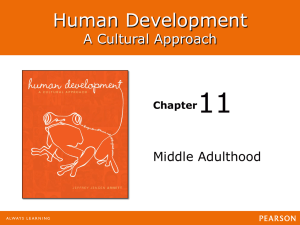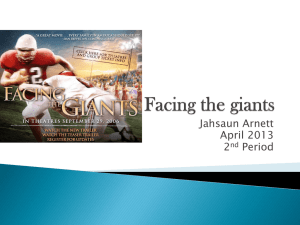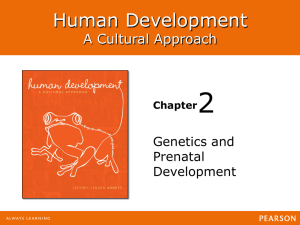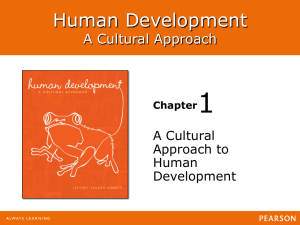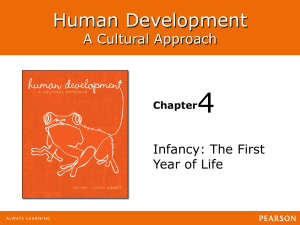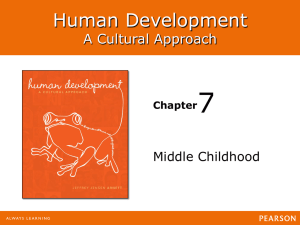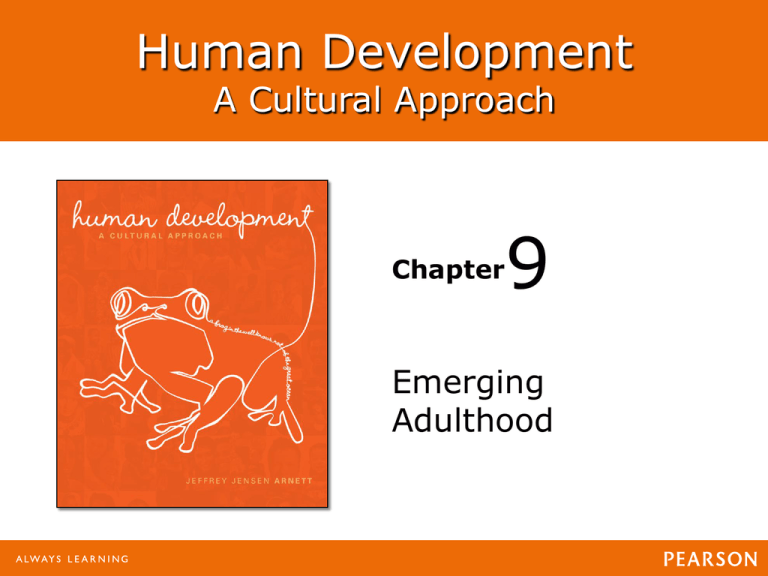
Human Development
A Cultural Approach
Chapter
9
Emerging
Adulthood
Human Development: A Cultural Approach
Jeffrey Jensen Arnett
Physical Development
Human Development: A Cultural Approach
Jeffrey Jensen Arnett
The Emergence of Emerging
Adulthood
• Time between adolescence and adult
roles:
Marriage
Increased education
Opportunities for women
Human Development: A Cultural Approach
Jeffrey Jensen Arnett
Map 9.1 Median Age at First Marriage in the United States Which states have the lowest and
highest age of first marriages? How does the median age of marriage differ between men and women?
How might you explain these differences? (continued on next slide)
Human Development: A Cultural Approach
Jeffrey Jensen Arnett
Map 9.1 Median Age at First Marriage in the United States Which states have the lowest and
highest age of first marriages? How does the median age of marriage differ between men and women?
How might you explain these differences? (continued from previous slide)
Human Development: A Cultural Approach
Jeffrey Jensen Arnett
The Emergence of Emerging
Adulthood
• There are five distinctive characteristics
of emerging adulthood
Age of identity explorations—explore
various possibilities of work and love
Age of instability—exploration leads to
instability
Human Development: A Cultural Approach
Jeffrey Jensen Arnett
Figure 9.1 Rate of Residential Change, Past Year, in the United States Why does the rate of
residential change peak in emerging adulthood? Source: U.S. Bureau of the Census (2003)
Human Development: A Cultural Approach
Jeffrey Jensen Arnett
The Emergence of Emerging
Adulthood
• Self-Focused—learning to be more selfsufficient before committing
• Age of feeling in-between—feeling of
being in transition
• Age of possibilities—potential for
dramatic changes
Human Development: A Cultural Approach
Jeffrey Jensen Arnett
Figure 9.2
Do You Feel You Have Reached Adulthood? Emerging adults often feel adult in some
ways but not others. Source: Arnett (2000)
Human Development: A Cultural Approach
Jeffrey Jensen Arnett
The Emergence of Emerging
Adulthood the Cultural Context
• Europe—has longest emerging
adulthood time
Age of marriage and parenthood around 30
• Asian—capable of supporting parents
financially
This may curtail identity exploration seen
in European countries
Human Development: A Cultural Approach
Jeffrey Jensen Arnett
The Emergence of Emerging
Adulthood the Cultural Context
• Emerging adulthood varies across
cultures
Developing countries tend to split between
urban and rural
Urban young people more likely to
experience emerging adulthood
Human Development: A Cultural Approach
Jeffrey Jensen Arnett
The Emergence of Emerging
Adulthood the Cultural Context
• Emerging adulthood varies across
cultures
Rural young people have fewer
opportunities for schooling and exploring
Globalization and tertiary education
participation increasing spread of emerging
adulthood
Human Development: A Cultural Approach
Jeffrey Jensen Arnett
Physical Changes of Emerging Adulthood
The Peak of Physical Functioning
• Emerging adulthood is a period of peak
physical functioning
VO2 peaks in early 20s
Reaction, grip strength, and bone density
are at its peak
Least susceptibility to physical illness
• Lifestyle encourages poor nutrition,
high stress, and lack of sleep
Human Development: A Cultural Approach
Jeffrey Jensen Arnett
Physical Changes of Emerging Adulthood
Sleep Patterns and Deficits
• College students more likely to show
symptoms of delayed sleep phase
syndrome
• 2/3 sleep problems; 1/4 severe sleep
disturbances
• Eveningness vs. Morningness
Human Development: A Cultural Approach
Jeffrey Jensen Arnett
Physical Changes of Emerging Adulthood
Sleep Patterns and Deficits
• Important for sleep hygiene
Wake up at same time each day
Get regular exercise
Take late afternoon naps
Limit caffeine intake
Avoid excessive alcohol intake
Human Development: A Cultural Approach
Jeffrey Jensen Arnett
Risk Behavior and Health Issues
Injuries and Fatalities
• Automobile accidents major threat to
life and health of emerging adults
• Car fatalities highest between ages 16–
24
Inexperience
Risky driving behavior—speed, driving
under the influence
Human Development: A Cultural Approach
Jeffrey Jensen Arnett
Figure 9.3
Rates of Car Injuries and Fatalities by Age Why are rates so high at ages 16-24?
Source: NHTSA (2009) (continued on next slide)
Human Development: A Cultural Approach
Jeffrey Jensen Arnett
Figure 9.3
Rates of Car Injuries and Fatalities by Age Why are rates so high at ages 16-24?
Source: NHTSA (2009) (continued from previous slide)
Human Development: A Cultural Approach
Jeffrey Jensen Arnett
Risk Behavior and Health Issues
Injuries and Fatalities
• Socialization impacts number of
accidents
• Personality characteristics can promote
high risk driving
• Reducing fatalities includes parental
involvement and monitoring
• Graduate Driver Licensing is also
effective
Human Development: A Cultural Approach
Jeffrey Jensen Arnett
Risk Behavior and Health Issues
Injuries and Fatalities
Human Development: A Cultural Approach
Jeffrey Jensen Arnett
Risk Behavior and Health Issues
Substance Abuse
• Substance abuse peaks in early 20s
• Peak and decline possibly explained by
unstructured socializing
College age students have more
unstructured time causing peak
• Role transition causes decline in
substance abuse
Human Development: A Cultural Approach
Jeffrey Jensen Arnett
Figure 9.5
Marijuana Use and Binge Drinking in Emerging Adulthood Rates of most kinds of
substance use peak in the early twenties. Source: Johnston et al. (2008)
Human Development: A Cultural Approach
Jeffrey Jensen Arnett
Cognitive Development
Human Development: A Cultural Approach
Jeffrey Jensen Arnett
Postformal Thought
Pragmatism
• Pragmatism—adapting logical thinking
to the practical constraints of real life
situations
• Aware of the impact of social factors in
any given situation
• Comparable to dialectical thought—
problems may have no clear solution
Human Development: A Cultural Approach
Jeffrey Jensen Arnett
Postformal Thought
Reflective Judgment
• Reflective judgment -capacity to
evaluate the accuracy and coherence of
evidence and arguments
• William Perry’s Dualistic Thinking
Multiple Thinking—awareness of duplicity
Relativism—compare merits of competing
views
Commitment—commit to certain viewpoint
Human Development: A Cultural Approach
Jeffrey Jensen Arnett
Tertiary Education
• Training beyond secondary school is
called tertiary education
• This has become a normative
experience with women outnumbering
men
Human Development: A Cultural Approach
Jeffrey Jensen Arnett
Map 9.2 Worldwide Enrollment in Tertiary Education Which countries have the highest and
lowest enrollment rates for higher education? How do these rates compare to the enrollment rates for
secondary school (as shown in Map 8.1)? What economic and cultural factors might explain these
variations?
Human Development: A Cultural Approach
Jeffrey Jensen Arnett
Tertiary Education Cultural
Variations in Tertiary Education
• Japan—relaxed and undemanding in
university years
4 years of sanctioned activities to think
• Europe—no general education
6 years studying specific discipline
• US/Canada—two years of general
education
Allows time for exploration
Human Development: A Cultural Approach
Jeffrey Jensen Arnett
Tertiary Education
Cultural Variations
• Most Americans will take 6 years to
earn a 4 year degree
• Major reason is financial
Human Development: A Cultural Approach
Jeffrey Jensen Arnett
Table 9.1
Ethnic Differences in Financial Support for College Based on a sample of 304
emerging adults aged 20–29. Source: Arnett (2004)
Human Development: A Cultural Approach
Jeffrey Jensen Arnett
Tertiary Education
Benefits of Tertiary education
• Higher earnings and occupational
status
• Verbal and quantitative skills
• Oral and written communication
• Distinct identity
• Social confidence
• Increased self concept and
psychological well-being
Human Development: A Cultural Approach
Jeffrey Jensen Arnett
Emotional and Social
Development
Human Development: A Cultural Approach
Jeffrey Jensen Arnett
Emotional and Self-Development
Self-Esteem
• Self-esteem
Awkwardness of physical appearance
declines
Peer evaluations from high school less
likely
Family relationships tend to improve
Greater degree of control over one’s life
Human Development: A Cultural Approach
Jeffrey Jensen Arnett
Figure 9.7
Changes in Self-Esteem Why does self-esteem rise during the emerging adult years?
Source: Monitoring the Future (2003)
Human Development: A Cultural Approach
Jeffrey Jensen Arnett
Emotional and Self-Development
Identity Development
• Identity formation historically thought
to occur in adolescence
• Emerging adulthood is time period of
importance
• Erik Erikson focused on identity versus
identity confusion as the adolescent
crisis
• Key areas to form identity are love,
work, and ideology
Human Development: A Cultural Approach
Jeffrey Jensen Arnett
Emotional and Self-Development
Identity Development
• Three elements :
Assessing abilities and strengths
Identifications that have accumulatedmodeling
Assess opportunities available to them in
society
• Marcia classified adolescents into one of
4 identity statuses
Human Development: A Cultural Approach
Jeffrey Jensen Arnett
The Four Identity Statuses
Human Development: A Cultural Approach
Jeffrey Jensen Arnett
Emotional and Self-Development
Identity Development
• Takes longer to reach identity
achievement than expected
• Progress occurs but mainly related to
occupation during emerging adulthood
Human Development: A Cultural Approach
Jeffrey Jensen Arnett
Figure 9.8 U.S. Study on Identity Achievement With age, more young people are classified in
identity achievement and fewer in diffusion. (A = achievement, M = moratorium, F = foreclosure, and D
= diffusion.) Source: Waterman (1999)
Human Development: A Cultural Approach
Jeffrey Jensen Arnett
Emotional and Self-Development
Identity Development
• Culture influences identity
Many cultures view self as interdependent
Exploration to establish identity not
possible in some cultures
•
(I.E. work/relationships)
Exploration of ideology occurs more in
Western countries
Globalization impacts development of
bicultural identity and/or hybrid identity
Human Development: A Cultural Approach
Jeffrey Jensen Arnett
Emotional and Self-Development
Ethnic Identity
• Identity more complex if a member of
ethnic minority group
• Internal conflict between ethnic
minority belief system and majority
belief system
• Four ways of responding to ethnic
awareness
Human Development: A Cultural Approach
Jeffrey Jensen Arnett
Table 9.3 Four Possible Ethnic Identity Statuses
Source: Based on Phinney & Devich-Navarro (1997)
Human Development: A Cultural Approach
Jeffrey Jensen Arnett
Emotional and Self-Development
Gender Development
• Ideas about gender become more
egalitarian
• Gender stereotypes still exist especially
in regards to work
Women’s work more likely to be rated less
favorable than men’s
Human Development: A Cultural Approach
Jeffrey Jensen Arnett
Emotional and Self-Development
Gender Development
• Boomerang effect also exists
Women whose work violated stereotypical
gender expectations are rated higher than
men’s work
• Generally, gender stereotypes lessen in
emerging adulthood
Human Development: A Cultural Approach
Jeffrey Jensen Arnett
Cultural Beliefs
Religious Development
• Christian Smith and Patricia Snell
(2010) found that:
Religious beliefs were stronger than
behavior
Religious doctrine is not as important as a
belief in God
More tolerant of religious differences
Religious beliefs related to higher wellbeing and lower high risk behaviors
Human Development: A Cultural Approach
Jeffrey Jensen Arnett
Table 9.4
Smith and Snell’s Five Religious Categories Source: Based on Smith & Snell (2010)
Human Development: A Cultural Approach
Jeffrey Jensen Arnett
Cultural Beliefs
Political Development
• Participation in conventional politics is
low
• Volunteer work and political
demonstration is high
• High involvement in political extremes
Human Development: A Cultural Approach
Jeffrey Jensen Arnett
Social and Cultural Contexts of
Development Family Relationships
• In United States most leave home
about 18–19 years of age
Common reasons for leaving are college,
cohabitation, and independence
• Increased quality of parental interaction
occur after leaving home
• Ethnic minorities staying at home
longer
• 40% of all emerging adults will return
to the nest at least once
Human Development: A Cultural Approach
Jeffrey Jensen Arnett
Social and Cultural Contexts of
Development Family Relationships
• European emerging adults stay at
home longer than United States
Value mutual support of family
Higher standard of living staying at home
• Parental understanding increases in
emerging adults
Human Development: A Cultural Approach
Jeffrey Jensen Arnett
Social and Cultural Contexts
of Development Friendships
• Intimacy grows in importance
• More self-disclosure and fewer shared
activities
• Increased time in unstructured
activities
• There is a decline in leisure activities as
people age
Human Development: A Cultural Approach
Jeffrey Jensen Arnett
Social and Cultural Contexts of
Development Love and Sexuality
• Emerging adulthood includes
experiencing a romantic and sexual
relationship
• Intimacy is a major component of
emerging adult relationship
• Seek similarities in a partner
Consensual validation
Human Development: A Cultural Approach
Jeffrey Jensen Arnett
Social and Cultural Contexts of
Development Love and Sexuality
• Cohabitation common in U.S., Canada
and northern European countries
• American cohabitation tends to be
unstable and short duration
• Those from divorced families likely to
cohabitate
• Cohabitation before marriage is linked
to higher likelihood of divorce
Human Development: A Cultural Approach
Jeffrey Jensen Arnett
Social and Cultural Contexts of
Development Love and Sexuality
• Emerging adults and sexual behavior:
Have higher rates of hooking up compared
to older adults
Contraceptive use high but inconsistent
Premarital sex rates highest in West and
African countries
Peak period for sexually transmitted
infections
Human Development: A Cultural Approach
Jeffrey Jensen Arnett
Social and Cultural Contexts of
Development Finding Adult Work
• Job search systematic and changing
• After tertiary education may struggle to
find work that pays enough to live on
• Without tertiary education basic skills
are needed to obtain employment
Human Development: A Cultural Approach
Jeffrey Jensen Arnett
Social and Cultural Contexts of
Development Unemployment
• Unemployment rates twice as high as
for adults beyond age 25
• Unemployment for young adults and
teens especially high for minorities
Manufacturing jobs have diminished
• Urban decline also impacted rise in
unemployment
Human Development: A Cultural Approach
Jeffrey Jensen Arnett
Social and Cultural Contexts of
Development Unemployment
William Wilson proposed correctives:
Upgrade education
Improve school-to-work programs
Improve access to employment
Provide government-funded public service
jobs
Human Development: A Cultural Approach
Jeffrey Jensen Arnett
Social and Cultural Contexts
of Development Media Use
• Internet use:
Used for college work
- Hours online negatively correlated with
grades
Social networking
Pornography
• Mobile phones -social networking and
communicating with friends
Human Development: A Cultural Approach
Jeffrey Jensen Arnett

